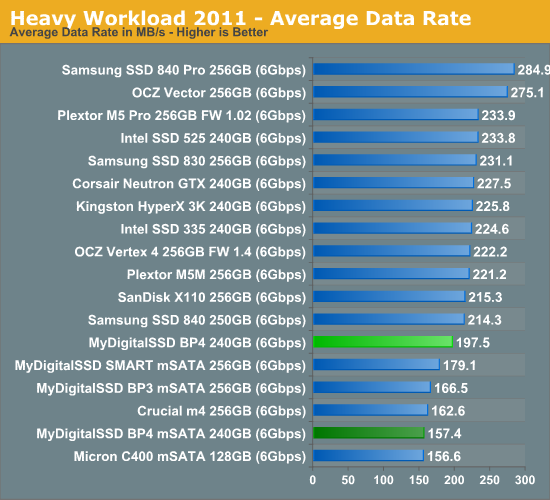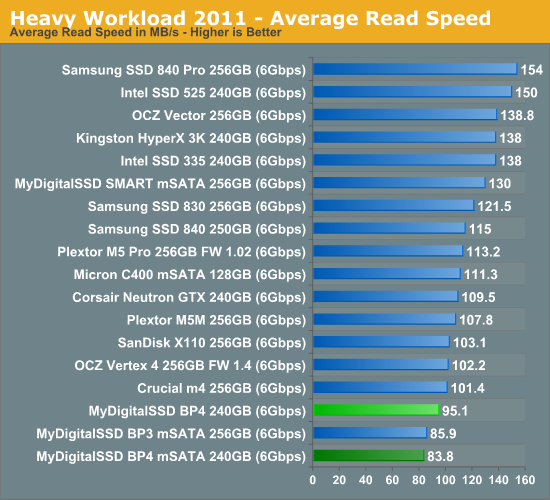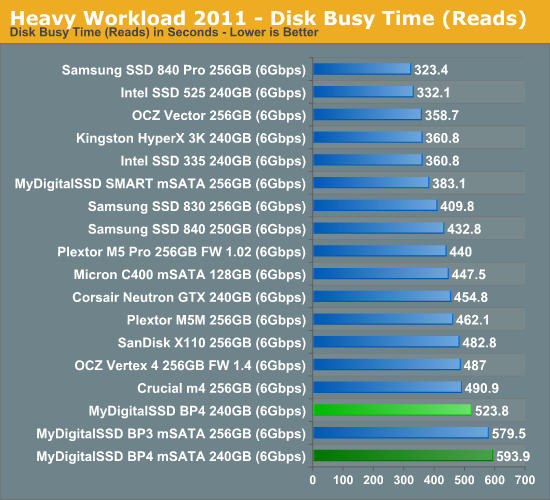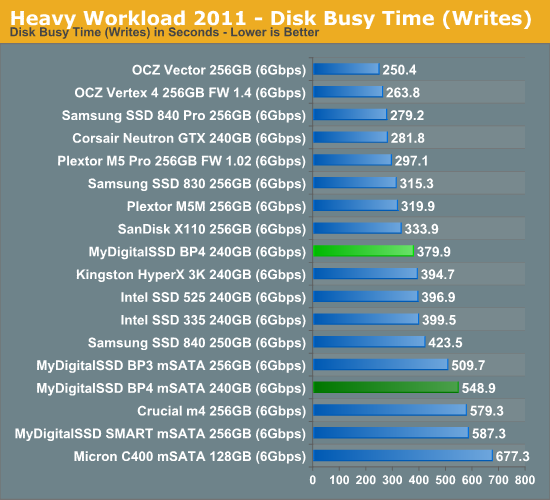MyDigitalSSD BP4 2.5" & mSATA (240GB) Review
by Kristian Vättö on April 3, 2013 11:13 AM ESTAnandTech Storage Bench 2011
Two years ago we introduced our AnandTech Storage Bench, a suite of benchmarks that took traces of real OS/application usage and played them back in a repeatable manner. Anand assembled the traces out of frustration with the majority of what we have today in terms of SSD benchmarks.
Although the AnandTech Storage Bench tests did a good job of characterizing SSD performance, they weren't stressful enough. All of the tests performed less than 10GB of reads/writes and typically involved only 4GB of writes specifically. That's not even enough exceed the spare area on most SSDs. Most canned SSD benchmarks don't even come close to writing a single gigabyte of data, but that doesn't mean that simply writing 4GB is acceptable.
Originally we kept the benchmarks short enough that they wouldn't be a burden to run (~30 minutes) but long enough that they were representative of what a power user might do with their system. Later, however, we created what we refer to as the Mother of All SSD Benchmarks (MOASB). Rather than only writing 4GB of data to the drive, this benchmark writes 106.32GB. This represents the load you'd put on a drive after nearly two weeks of constant usage. And it takes a long time to run.
1) The MOASB, officially called AnandTech Storage Bench 2011—Heavy Workload, mainly focuses on the times when your I/O activity is the highest. There is a lot of downloading and application installing that happens during the course of this test. Our thinking was that it's during application installs, file copies, downloading, and multitasking with all of this that you can really notice performance differences between drives.
2) We tried to cover as many bases as possible with the software incorporated into this test. There's a lot of photo editing in Photoshop, HTML editing in Dreamweaver, web browsing, game playing/level loading (Starcraft II and WoW are both a part of the test), as well as general use stuff (application installing, virus scanning). We included a large amount of email downloading, document creation, and editing as well. To top it all off we even use Visual Studio 2008 to build Chromium during the test.
The test has 2,168,893 read operations and 1,783,447 write operations. The IO breakdown is as follows:
| AnandTech Storage Bench 2011—Heavy Workload IO Breakdown | ||||
| IO Size | % of Total | |||
| 4KB | 28% | |||
| 16KB | 10% | |||
| 32KB | 10% | |||
| 64KB | 4% | |||
Only 42% of all operations are sequential; the rest ranges from pseudo to fully random (with most falling in the pseudo-random category). Average queue depth is 4.625 IOs, with 59% of operations taking place in an IO queue of 1.
Many of you have asked for a better way to really characterize performance. Simply looking at IOPS doesn't really say much. As a result we're going to be presenting Storage Bench 2011 data in a slightly different way. We'll have performance represented as Average MB/s, with higher numbers being better. At the same time we'll be reporting how long the SSD was busy while running this test. These disk busy graphs will show you exactly how much time was shaved off by using a faster drive vs. a slower one during the course of this test. Finally, we will also break out performance into reads, writes, and combined. The reason we do this is to help balance out the fact that this test is unusually write intensive, which can often hide the benefits of a drive with good read performance.
There's also a new light workload for 2011. This is a far more reasonable, typical every day use case benchmark. It has lots of web browsing, photo editing (but with a greater focus on photo consumption), video playback, as well as some application installs and gaming. This test isn't nearly as write intensive as the MOASB but it's still multiple times more write intensive than what we were running last year.
We don't believe that these two benchmarks alone are enough to characterize the performance of a drive, but hopefully along with the rest of our tests they will help provide a better idea. The testbed for Storage Bench 2011 has changed as well. We're now using a Sandy Bridge platform with full 6Gbps support for these tests.
AnandTech Storage Bench 2011—Heavy Workload
We'll start out by looking at average data rate throughout our heavy workload test:

The BP4 is definitely not a record breaker and it's about 10-15% slower than most SSDs. The mSATA version is in fact slower than the mSATA BP3, although that was somewhat expected given the synthetic tests (though that's a tradeoff I'm willing to make for much, much better IO consistency). If we look at the breakdown, the BP4 is the slowest in reads but not by a large margin, so it's really the write performance that needs improvement (especially when writing to random LBAs).















35 Comments
View All Comments
Kristian Vättö - Wednesday, April 3, 2013 - link
Intel 525 is mSATA only, so the scores there are for mSATA version ;)It really depends on the firmware and hardware you're using. For example, Intel 525 is actually slightly faster than the 520 or 335, which may be due to newer firmware or higher quality NAND, but Plextor M5M is a bit slower than its 2.5" counterpart. A lot depends on the controller/firmware design and how much that relies on parallelism. SandForce does have a minor advantage there because they write less to the NAND due to compression, so you can get away with less (or slower) NAND.
The overall problem with mSATA is that there really aren't that many drives available, especially in the retail market. Most drives are OEM only (like Samsung's) so getting them in for testing is harder.
jhoff80 - Wednesday, April 3, 2013 - link
Aaah, right, I got it confused with the 520. My mistake.DanNeely - Wednesday, April 3, 2013 - link
"Most drives are OEM only (like Samsung's) so getting them in for testing is harder."Sounds like you just need to start voiding warranty stickers on review ultrabooks to stick the drives into the benchmark box after taking pictures of what's inside the shell.
Kristian Vättö - Wednesday, April 3, 2013 - link
Two problems with that:1. Manufacturers don't usually like laptop review samples to be taken into pieces. Having good connections with manufacturers is one of the most important things in this field, so we can't just do what we wish -- we also have to respect manufacturers' requests. Legally all review samples are property of the sender/manufacturer.
2. Laptop and SSD reviews aren't done in the same place; in fact I'm not even on the same continent as the others. Thus it's not possible (or worthwhile) to send the SSD to me for testing, especially as most laptops only have a few week review period. On the other hand, Jarred/Dustin/Vivek could test the drive, assuming they have a modern desktop, but I'm not sure if that's worth it because dealing with different setups always represents some potential issues when it comes to consistency and they already have tons of work to do.
Lets put this in another way: What mSATA SSDs would you like to see tested? I can always ask if the manufacturers can give us review samples, even though the drive may not be available for retail.
msahni - Wednesday, April 3, 2013 - link
Hi there,I am contemplating buying mSATA drives 240GB-256GB range. It is really becoming confusing to purchase a drive considering so many different specs.
My options are
1) Crucial m4 mSATA 256GB http://www.newegg.com/Product/Product.aspx?Item=N8...
2) Plextor M5M 256GB http://www.newegg.com/Product/Product.aspx?Item=N8...
3) Intel SSD 525 240GB http://www.newegg.com/Product/Product.aspx?Item=N8...
4) Mushkin Enhanced Atlas 240GB http://www.newegg.com/Product/Product.aspx?Item=N8...
I have not been able to get a head to head comparison of the drives anywhere. Most of the tech spec shootouts are of these drives against SSDs or older models.
Could you please advise which of these drives in your opinion would be the most eligible buy in a real world consumer scenario..
Cheers....
MyDigitalSSD - Thursday, April 4, 2013 - link
Visit Amazon and search bp4 240gb mSATA there are a few still left in stock. Best deal on one right now.Kristian Vättö - Thursday, April 4, 2013 - link
I would pick either Crucial or Plextor. The Plextor one is a bit faster and Plextor also has very good reputation when it comes to reliability, although in this case the Crucial is "more proven" as it's been out longer. Both are good choices, so this is a matter of personal preference.LouisPR - Wednesday, April 3, 2013 - link
Happy to see a review about the BP4. I own it since mid February if I'm not mistaken and it's awesome!Vepsa - Wednesday, April 3, 2013 - link
I really like the price of $160 for the 240GB drive. Seriously considering getting one now and a second later for RAID0.jamyryals - Wednesday, April 3, 2013 - link
I got one of the 256GB Samsung 830 SSDs for $160. It was a great price for a drive on sale. I'm very happy to see retail starting at that price for a comparable drive. Time to wait and see what BP4's reliability will be like before I jump in on a nicely priced ~500GB.